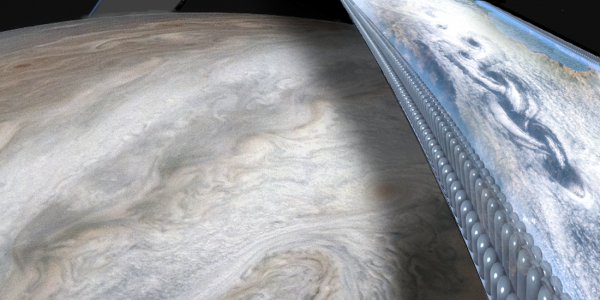BY LETTER
Pneumatically Supported Structure (PSS)
Technology > Application > Construction
Technology > Application > Everydaytech
Technology > Application > Infrastructure
Technology > Application > Materials Technology
Technology > Application > Everydaytech
Technology > Application > Infrastructure
Technology > Application > Materials Technology
 Image from Steve Bowers | |
| A supramundane stripworld with pneumatically supported airwalls | |
There are several advantages of utilizing gas pressure to support against compressive or flexural loading. PSSs are able to support loads using a minimum of material mass. This is possible because the strongest materials have very high specific tensile strengths. Suitable high tensile materials are able to contain pressurized gases. Any compression or flexural loading applied to a PSS raises the pressure of the contained gas incrementally, and the gas pushes outward against its containment proportionally more--all applied loads are thereby converted into tensile loads. Many of the bulk materials that possess high tensile strength are composed of fibers and are or can be intrinsically flexible. Flexible materials allow PSSs to be compactly stored in a non-inflated state. By adjusting the gas pressure, the stiffness of a PSS can be tuned across the gradient from flexible to rigid.
PSSs have several potential disadvantages, however, proper design and implementation can largely remove them. PSSs are often equipped with self-sealing and repair technology that can cope with multi-millimeter scale puncture damage. To resist against structural failure due to larger scale damage like cuts, the gas volume is subdivided into cells. Small valves may be incorporated into the cells' envelopes, allowing them to transfer pressurized gas from cell to cell. It is often unnecessary that the entire gas volume be subdivided into cells, just the outer layers that may be subjected to being cut. Damaged cells can self-repair and be repressurized through their neighbors. Because of their low mass density, pneumatically supported architecture must be securely anchored or ballasted to resist against being blown away by wind.
If PSSs are pressurized by helium or another light gas, and if the PSSs displace sufficient atmosphere, they can achieve aerostatic flight. All PSSs have a density low enough that they float on any liquid unless they are tethered or ballasted under the surface.
PSSs can be created in a wide variety of shapes. The most materially-efficient are spheres and dome-capped cylinders. Rectangular prisms and other shapes with planar faces can be created by using internal tensile elements (lines, sheets, etc.) to restrain the PSS's gas envelope from ballooning out into a curved surface. Complex shapes can be created by irregular length tensile elements and or by combining PSS cells together.
If PSSs are divided into many small cells (e.g. 0.5 cm^3) they have a closed-cell foam structure, and are maximally resistant to catastrophic pressure loss. Foam PSSs may be engineered to be permanently inflated (they are pressurized during manufacture) or, like larger PSS cells, they incorporate valves (in this case micro-valves) into their cell envelopes to transfer gas.
If they are constructed from light graphene-based materials and they are pressurized by helium, foam PSSs can float aerostatically. Graphene membranes are impermeable to helium, so they can remain inflated for an extended period. Many structures which are buoyant in air are constructed in this way, such as floating buildings, bubblehabs and sunclouds.
Some PSSs are robotic, and alter their shape using Morphable Pressurised Tensegrity Cell technology and by varying pneumatic pressure in cellular units. A small but significant number of sophont clades utilise pneumatic bodies, often with very lightweight and flexible bodyplans capable of quickly changing size and shape, and if filled with a buoyant gas, they may be capable of flight.
Image from Steve Bowers | |
| This launch tube is 30km kigh and is held up by a pneumatically supported structure. Surface to orbit craft are accelerated along an evacuated tube until they are above the densest part of the atmosphere. | |
Pneu-robotic systems, pneumatically supported buildings, boat hulls, aircraft wings, machine frames, furniture, tires, and sports equipment are common applications of PSS technology.
Related Articles
Appears in Topics
Development Notes
Text by Johnny Yesterday
Additional material by Steve Bowers
Initially published on 13 June 2021.
Additional material by Steve Bowers
Initially published on 13 June 2021.
Additional Information
A demonstration of pneumatically-operated robotic design
https://www.vinerobots.org/
https://www.vinerobots.org/






